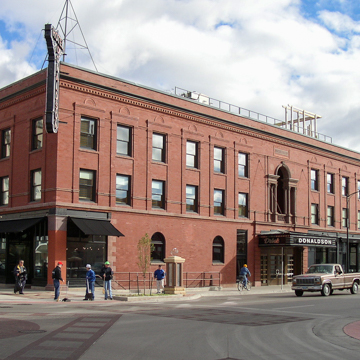You are here
Hotel Donaldson (International Order of Odd Fellows [IOOF] Lodge Hall)
Minneapolis architects George W. Orff and Edgar E. Joralemon were among several out-of-town firms that established temporary offices in Fargo immediately after the Great Fargo Fire of 1893. Occasionally collaborating with Leroy S. Buffington, the work of Orff and Joralemon is especially distinguished. Erected as part of Fargo’s rebuilding after the 1893 fire, the International Order of Odd Fellows (IOOF) Hall was placed on the second floor, above the first-floor stores. In 1915–1916, a third story was added and the upper stories were converted to the Hotel Donaldson. The balcony over the main entrance is framed by a Palladian motif, elegantly rendered in red sandstone. Overall, the design can be characterized as Renaissance Revival. In 2002 the hotel reopened following conversion to the “HoDo” boutique hotel and restaurants, with period neon signage, public meeting places, and a rooftop terrace.
Writing Credits
If SAH Archipedia has been useful to you, please consider supporting it.
SAH Archipedia tells the story of the United States through its buildings, landscapes, and cities. This freely available resource empowers the public with authoritative knowledge that deepens their understanding and appreciation of the built environment. But the Society of Architectural Historians, which created SAH Archipedia with University of Virginia Press, needs your support to maintain the high-caliber research, writing, photography, cartography, editing, design, and programming that make SAH Archipedia a trusted online resource available to all who value the history of place, heritage tourism, and learning.









